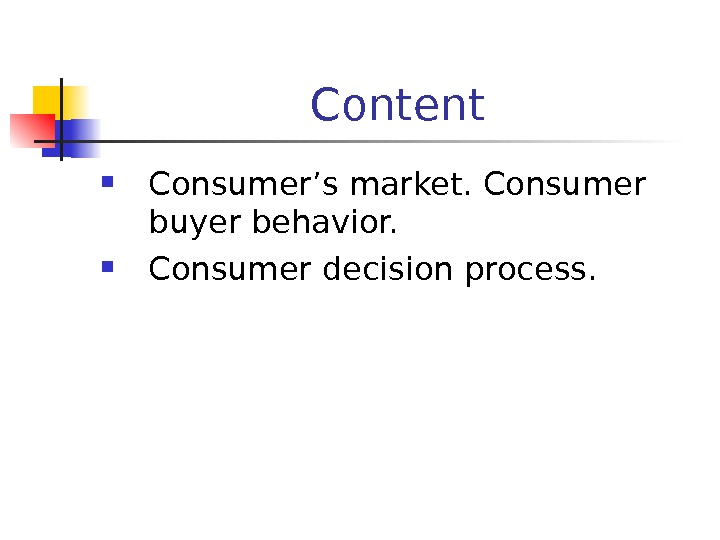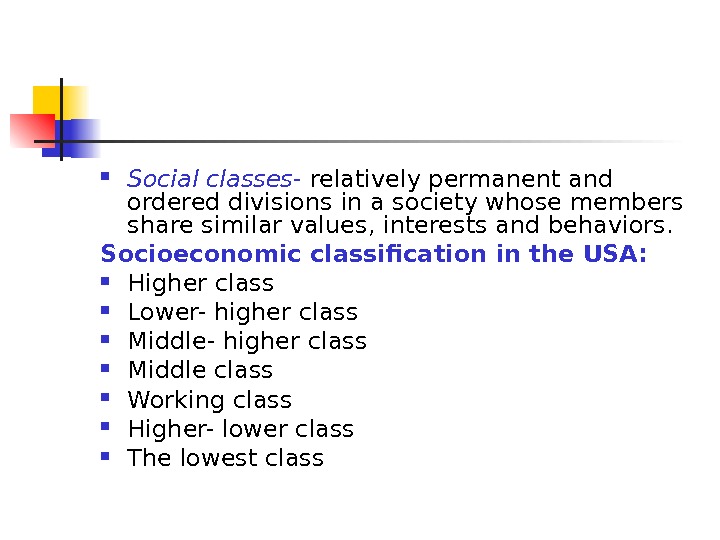Marketing Lecture 5 “Consumer buyer behavior” Lecturer:












marketing._lecture_n5.ppt
- Размер: 197 Кб
- Количество слайдов: 11
Описание презентации Marketing Lecture 5 “Consumer buyer behavior” Lecturer: по слайдам
 Marketing Lecture 5 “Consumer buyer behavior” Lecturer: DBA, Omarova A. Sh.
Marketing Lecture 5 “Consumer buyer behavior” Lecturer: DBA, Omarova A. Sh.
 Content Consumer’s market. Consumer buyer behavior. Consumer decision process.
Content Consumer’s market. Consumer buyer behavior. Consumer decision process.
 Consumer’s market. Consumer buyer behavior. Consumer’s market is all the individuals and households who buy or acquire goods and services for personal consumption. Consumer buying behavior is the buying behavior of final consumers- individuals and households who buy goods and services for personal consumption.
Consumer’s market. Consumer buyer behavior. Consumer’s market is all the individuals and households who buy or acquire goods and services for personal consumption. Consumer buying behavior is the buying behavior of final consumers- individuals and households who buy goods and services for personal consumption.
 Factors influencing on behavior
Factors influencing on behavior
 Culture is the set of basic values, perceptions, wants and behavior learned by a member of society from family and other important institutions. American society- individualism, material comfort, freedom, super-yang appearance. Cross- culture influence — differences between cultural values of different countries. Sub- culture — subgroups within the lager, or national, culture with unique values, ideas, and attitudes. Each of group exhibits sophisticated social and cultural behaviors that affect their buying patterns
Culture is the set of basic values, perceptions, wants and behavior learned by a member of society from family and other important institutions. American society- individualism, material comfort, freedom, super-yang appearance. Cross- culture influence — differences between cultural values of different countries. Sub- culture — subgroups within the lager, or national, culture with unique values, ideas, and attitudes. Each of group exhibits sophisticated social and cultural behaviors that affect their buying patterns
 Social classes — relatively permanent and ordered divisions in a society whose members share similar values, interests and behaviors. Socioeconomic classification in the USA: Higher class Lower- higher class Middle class Working class Higher- lower class The lowest class
Social classes — relatively permanent and ordered divisions in a society whose members share similar values, interests and behaviors. Socioeconomic classification in the USA: Higher class Lower- higher class Middle class Working class Higher- lower class The lowest class
 Social factors Reference groups Family Roles and status
Social factors Reference groups Family Roles and status
 Reference groups — people to whom an individual looks as a basis for self- appraisal or as a source of personal standards. Reference groups affect consumer purchases because they influence the information, attitudes, and aspiration levels that help set a consumer’s standards. Primary groups — groups, with whom there is regular but informal interaction- family, friends, neighbors and fellow workers. Secondary groups — which are more formal and have less- regular interaction- religious groups, professional associations, etc. Aspiration group — is one that a person wishes to be a member of or wishes to be identified with, such as a professional society
Reference groups — people to whom an individual looks as a basis for self- appraisal or as a source of personal standards. Reference groups affect consumer purchases because they influence the information, attitudes, and aspiration levels that help set a consumer’s standards. Primary groups — groups, with whom there is regular but informal interaction- family, friends, neighbors and fellow workers. Secondary groups — which are more formal and have less- regular interaction- religious groups, professional associations, etc. Aspiration group — is one that a person wishes to be a member of or wishes to be identified with, such as a professional society
 Family members can strongly influence buyer behavior. Family of orientation are parents and relatives. They provide a person with an orientation towards religion, politics and economies, sense of personal ambition. Family of procreation are spouse and children.
Family members can strongly influence buyer behavior. Family of orientation are parents and relatives. They provide a person with an orientation towards religion, politics and economies, sense of personal ambition. Family of procreation are spouse and children.
 During decision making process people can play the following roles: Initiator or information gatherer — the person who first suggests or thinks of the idea of buying a particular product or service. Influencer — a person whose view or advice influences buying decisions. Decision maker — the person who ultimately makes a buying decision or any part of it-whether to by, what to buy, how to buy, or where to buy. Purchaser — the person who makes an actual purchase. User — the person who consumers or uses a product or service.
During decision making process people can play the following roles: Initiator or information gatherer — the person who first suggests or thinks of the idea of buying a particular product or service. Influencer — a person whose view or advice influences buying decisions. Decision maker — the person who ultimately makes a buying decision or any part of it-whether to by, what to buy, how to buy, or where to buy. Purchaser — the person who makes an actual purchase. User — the person who consumers or uses a product or service.
 Roles and status. A person belongs to many groups- family, clubs, organizations. The person’s position in each group can be defined in terms of both role and status. A role consists of the activities that people are expected to perform according to the people around them. Each role carries a status reflecting the general esteem given to it by society. People often choose products that show their status in the society.
Roles and status. A person belongs to many groups- family, clubs, organizations. The person’s position in each group can be defined in terms of both role and status. A role consists of the activities that people are expected to perform according to the people around them. Each role carries a status reflecting the general esteem given to it by society. People often choose products that show their status in the society.

